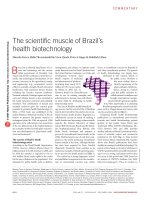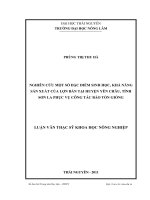Sinh học, khả năng di truyền của từng tế bào
Bạn đang xem bản rút gọn của tài liệu. Xem và tải ngay bản đầy đủ của tài liệu tại đây (288.19 KB, 5 trang )
DC8 VOLUME 22 SUPPLEMENT DECEMBER 2004 NATURE BIOTECHNOLOGY
COMMENTARY
has a relatively long history of sci-
ence and technology, and the current
leftist government of President Luiz
Inácio Lula da Silva continues to prioritize sci-
entific and technological development in the
country. Successes in the agricultural, energy
and engineering (e.g., aeronautics) sectors
reflect its scientific strength. Brazil’s terrestrial
biodiversity, with numerous diverse biomes
including the Cerrado, Amazon rainforest,
Pantanal wetlands, Caatinga region, and Arau-
caria and Atlantic forests, is also unrivaled in
the South American continent and probably
elsewhere. This combination of natural and
scientific resources gives the country great
potential to promote health biotechnology. In
2004, a DNA bank was established at the
Jardim Botânico (Botanical Garden) in Rio de
Janeiro to preserve the genetic material of
endangered plant life. With an expected 1,000
specimens to be collected per year, researchers
at the two laboratories at the Jardim Botânico
are currently involved in both plant conserva-
tion and development of plant-based medi-
cines and treatments
1
.
The success of Brazil’s health
biotechnology sector
According to the World Health Organization
(WHO, Geneva), diabetes affected about 33
million people in South America in 2000, and
by 2030 the number is expected to rise to
66.8 million. Brazil ranks eighth in the world
for the rate of diabetes in the population
2
.The
demands for public health, such as diabetes
management, and reliance on imports create
major financial costs for Brazil. Statistics from
the United Nations Conference on Trade and
Development (Geneva) show
Brazil’s imports of medicinal
and pharmaceutical products
increasing from nearly $170
million in 1981 to just under
$2 billion in 2002 (ref. 3).
However, Brazil is in a favorable posi-
tion to use its existing strengths and
achievements to become more self-reliant
in these fields by developing its health
biotechnology sector.
One case of Brazilian health biotechnol-
ogy success cited by several of the 33 Brazilian
experts interviewed for this study is its recom-
binant human insulin product. Regarded as a
collaborative success in terms of tackling a
health burden and increasing technoscientific
capacity, the Federal University of Minas
Gerais (Belo Horizonte, Brazil) and the Brazil-
ian biopharmaceutical firm Biobrás (São
Paulo, Brazil) developed and patented a
process for recombinant human insulin in the
1990s. Biobrás became one of only four com-
panies in the world producing recombinant
human insulin at the time. Although Biobrás
has since been acquired by Novo Nordisk
(Bagsværd, Denmark), there continue to be
numerous examples of Brazil’s growing capac-
ity to meet its own health needs (see Ta b le 1).
The nation has a strong diagnostics sector
4
and established competencies in the manufac-
ture of conventional vaccines (e.g., yellow
fever), a recombinant vaccine for hepatitis B
and other recombinant proteins. The growth
of health biotechnology has largely been
attributed to the research efforts of
the public sector. Nowhere is
this more evident than in
Brazil’s sequencing of the
plant pathogen Xylella fas-
tidiosa.Acting as a launch
pad, this public initiative in-
stilled national confidence and
brought international recogni-
tion for Brazil’s genomics capabil-
ities. More importantly, it is catalyzing
Brazilian postgenomic research into dis-
eases, such as Chagas disease and cancer, with
vaccines and stem cells (see Box 1).
Comparing Brazil’s health biotechnology
publications in international peer-reviewed
journals and health biotechnology patents
granted in the United States Patent and
Tr ademark Office (USPTO, Washington, DC,
USA) between 1991 and 2002 provides
another indicator of Brazil’s innovation level in
terms of scientific output and commercial
potential in the field (Fig. 1). Data derived
from Science-Metrix (Montréal, PQ, Canada)
shows that Brazil’s publications have been
steadily increasing in health biotechnology
5
.Its
patent activity based on inventors’addresses in
USPTO-granted patents in health biotechnol-
ogy is not as strong, and patent activity does
not occur in this period until 1996 (based on
an analysis of USPTO’s database, July 2004;
Thus, in contrast to
The scientific muscle of Brazil’s
health biotechnology
Marcela Ferrer, Halla Thorsteinsdóttir, Uyen Quach, Peter A Singer & Abdallah S Daar
Marcela Ferrer is Assistant Professor, Department of Public Policies, Institute for Public Affairs, University of Chile Diagonal Paraguay 265, Piso 13, Santiago, Chile;
Halla Thorsteinsdóttir is Assistant Professor, Canadian Program on Genomics and Global Health, University of Toronto Joint Centre for Bioethics and Department
of Public Health Sciences, 88 College Street, Toronto, Ontario M5G 1L4, Canada; Uyen Quach is Research Assistant, Canadian Program on Genomics and Global
Health, University of Toronto Joint Centre for Bioethics, 88 College Street, Toronto, Ontario M5G 1L4, Canada; Peter A. Singer is Sun Life Financial Chair and
Director, University of Toronto Joint Centre for Bioethics; Professor of Medicine, University of Toronto; and Co-director Canadian Program on Genomics and Global
Health, 88 College Street, Toronto, Ontario M5G 1L4 Canada; and Abdallah S. Daar is Director of Ethics and Policy, McLaughlin Centre for Molecular Medicine;
Professor of Public Health Sciences and of Surgery, University of Toronto; and Co-director Canadian Program on Genomics and Global Health, University of Toronto
Joint Centre for Bioethics, 88 College Street, Toronto, Ontario M5G 1L4, Canada. e-mail:
B
RAZIL
Illustration by Erin Boyle
© 2004 Nature Publishing Group />COMMENTARY
NATURE BIOTECHNOLOGY VOLUME 22 SUPPLEMENT DECEMBER 2004 DC9
its publication record, Brazil’s patenting
has been uneven and limited.
Main features of the Brazilian
sector
From as early as the 1970s, Brazilian
national governments have focused
efforts on promoting health biotech-
nology in the region. This has resulted
in close collaborations between re-
search institutes and universities and an
expanding, but as yet rather small and
fragmented, private sector. Because the
Brazilian public has difficulty clari-
fying differences between health bio-
technology with agricultural biotech-
nology, further efforts are required to
inform the population about the risks
and benefits of biotechnology and the
science underlying it.
Government. Biotechnology development
was an early priority for Brazilian govern-
ments. In the 1970s, Brazil’s National Research
Council (CNPq) launched two programs that
pioneered biotechnology work in the country,
the Integrated Programme on Genetics (PID)
and the Integrated Programme on Tropical
Diseases (PIDE). In 1981, the government set
up the National Biotechnology Programme
(PRONAB) to integrate institutions and budg-
ets in agricultural, energy and health biotech-
nology. Three years later, it set up a national
program aimed at supporting science and
technology development (Programa de Apoio
ao Desenvolvimento Científico e Tecnológico;
PADCT) that included capacity building in
biotechnology as an important element. The
main goals of the program were to train scien-
tists, develop scientific infrastructure and
promote linkages among universities, institu-
tions and industry. The third phase of this pro-
gram started in 1997, and approximately 17%
of its budget was allocated to biotechnology
6
.
Despite the frequent turnover of govern-
ments in Brazil, biotechnology development
has received uninterrupted support. At the fed-
eral level, the Ministry of Science and
Te c hnology has played a leading role in
biotechnology development, and at the state
level, leadership has come from the States
Research Support Foundations (FAPs). The
FAP in São Paulo, FAPESP, has been especially
active and instrumental in organizing and
financing biotechnology projects concentrated
in the southeast part of the country.
Brazil is revising its regulatory and legal
system in response to biotechnology develop-
ments. For instance, the government passed
a patenting law in 1997 to be compatible
with the World Trade Organization’s
(Geneva) Agreement on Trade-Related
Aspects of Intellectual Property Rights
(TRIPS), to which Brazil is a signatory
7
.
Although drug regulation laws have
existed in Brazil since the late 1970s,
the National Sanitary Surveillance
Agency (ANVISA, Brasilia) was estab-
lished later, in 1999, to regulate all
drugs and medical equipment in the
country
8
.The first biosafety law was
ratified in 1995 to regulate the intro-
duction of genetically modified organ-
isms. However, it covered more than
environmental biosafety and broadly
encompassed areas related to health
biotechnology research such as the ban-
ning of genetic manipulation of germ-
line cells and the production,storage, or
manipulation of embryos. These put tight
restrictions on health biotechnology research
in the country
9
.In October 2004, the senate
amended and approved a new biosafety law
that would allow research on stem cells taken
from surplus embryos, left over from in vitro
fertilization procedures and already frozen for
three years. Before it becomes law, it will need
to be approved by the Chamber of Deputies
10
.
Brazil’s Ministry of Environment is now revis-
ing legislation on access to biological resources
to ease restrictions on Brazilian scientists
carrying out biodiversity research. The restric-
tions will be focused more on the commercial-
ization of findings
11
.
Research institutes and universities. Brazil-
ian research institutions and universities
are both productive in the health biotechnol-
ogy field. The number of health biotechnology
papers published in the international peer-
Table 1 Examples of Brazilian health biotechnology products
Sector Type Application Producer
a
Vaccines Recombinant hepatitis B surface antigen Hepatitis B Instituto Butantan
Attenuated virus Yellow fever Bio-Manguinhos (FIOCRUZ)
Autologous whole cell Prostate cancer FK Biotecnologia
Therapeutics Recombinant human insulin Diabetes Biobrás/Novo Nordisk
Recombinant erythropoietin-α Anemia Instituto Butantan
Monoclonal antibodies Immunotherapy FK Biotecnologia
Diagnostics Recombinant antigens Chagas disease Bio-Manguinhos (FIOCRUZ)
Peroxidase/anti-peroxidase and alkaline Antibody detection FK Biotecnologia
phosphatase/anti-alkaline phosphatase immunoassays
Molecular Various Simbios Produtos Biotecnológicos (São Paulo, Brazil)
Services Novel natural molecules R&D Extracta Moleculas Naturais
Biomedical software Genomics R&D Scylla Bioinformatics (São Paulo, Brazil).
DNA services Genetic testing Gene–Núcleo de Genética Médica (Belo Horizonte, Brazil)
a
Name of an associated research institute is in parentheses.
Number of publications
Number of patents
0
50
100
150
200
2
0
02
2001
200
0
199
9
1
9
98
199
7
1
9
96
1
9
95
1
9
94
1
9
93
1
9
92
1
9
91
0
2
4
6
8
10
PatentsPublications
Figure 1 Brazilian publications and USPTO patents in health
biotechnology (1991–2002). Source: Publication data are from
ref. 5. Patent data are from the USPTO.
Illustration by R. Henretta
© 2004 Nature Publishing Group />COMMENTARY
DC10 VOLUME 22 SUPPLEMENT DECEMBER 2004 NATURE BIOTECHNOLOGY
reviewed literature by Brazilian scientists has
increased substantially since the early 1990s
(ref. 5). The number of publications in health
biotechnology jumped from 96 in 1998 to 179
in 2001. According to the respondents in this
study, a few public research institutes, mainly
the Oswaldo Cruz Foundation (FIOCRUZ, Rio
de Janeiro, Brazil) and the Institute Butantan
(São Paulo, Brazil), play a leading role in the
nation’s health biotechnology sector.
FIOCRUZ is a federal institute founded
in 1900 with the goals of controlling bubonic
plague, yellow fever and smallpox
12
.This
institution, affiliated to Brazil’s Ministry of
Health (Brasilia), has become a strong pro-
ducer of new knowledge in the health biotech-
nology field in Brazil, and its scientists
published more than 16% of the Brazilian
papers in the international peer-reviewed lit-
erature from 1991 to 2002. In addition, it pro-
vides training on a variety of topics related to
the biomedical field. The institute also runs a
manufacturing plant, Bio-Manguinhos (Rio
de Janeiro, Brazil), that has vaccine and diag-
nostics production facilities (it is the largest
Brazilian manufacturer of vaccines).
The Butantan Institute was established in
1989 and has had a strong public health con-
nection. Like FIOCRUZ, it plays diverse roles
in the health biotechnology sector, including
research, training, technological development
as well as manufacturing and commercializa-
tion of health biotechnology products. In addi-
tion to these two public research institutes,
respondents in this study identified the Ludwig
Institute for Cancer Research, a private institu-
tion in São Paulo, Brazil, as an active contribu-
tor to the health biotechnology sector.
There are about 100 universities in Brazil,
and they publish 80% of all Brazilian health
biotechnology papers in international peer-
reviewed journals
5
.The largest contributor is
the University of São Paulo, publishing almost
26% of this type of paper. Both the Federal
University of Rio de Janeiro and the Federal
University of Minas Gerais are also publishing
extensively in this field, with around 11% of
these papers each. The universities are heavily
involved in domestic collaboration, which
has increased extensively since 1991 (ref. 5).
For instance, the Ludwig Institute collaborates
extensively with the Federal University of
Minas Gerais, and both the University of Rio
de Janeiro and the Federal University of Minas
Gerais collaborate extensively with FIOCRUZ.
The X. fastidiosa sequencing project is an
example of the close collaboration among
researchers in the universities and the public
research institutes. They set up a ‘virtual insti-
tute’, in which scientists remained in their
original institutions but collaborated closely.
The project involved 34 biology laboratories
and one bioinformatics center located across
the country
13
.
Industry. In the past decade, the Brazilian
private biotechnology sector has quickly
expanded, with most companies concentrated
in the south and southeast parts of the country.
In 1993, there were 76 biotechnology firms in
Brazil; by 2001, their number had increased to
354 (ref. 4). Approximately 70% are local pri-
vate firms, 25% are multinational and 5% are
state-owned firms
14
.Oftheir combined prod-
ucts, 26% are for the health care market and
the rest are for agricultural, environmental and
industrial fields.
Brazil has a large pharmaceutical market
(the 11th largest in the world), attracting
multinational pharmaceutical companies,
such as GlaxoSmithKline (London, UK),
Roche (Basel, Switzerland) and Sanofi-Aventis
(Strasbourg, France). Those firms are not
heavily involved in health biotechnology inno-
vation in the country, however. Similar to
multinational firms found in other developing
countries, large Brazilian companies have low
innovation and patenting rates
15
.
Efforts by the government to attract private
sector investment in biotechnology commer-
cialization are limited by a decree prohibiting
university professors from being employed by
industry. This discourages them from becom-
ing involved in the formation of spinoff
companies. A new bill to encourage private
sector participation, the so-called Innovation
Law, was approved in 2004 by the Chamber of
Deputies and is now under discussion at the
Senate
16
.Ifapproved, professors will be able to
work for limited periods in the private sector.
Respondents in this study said that researchers
from both public research institutions and
universities and even the government have
mixed opinions about this law. However, uni-
versity spinoffs are not unheard of in the coun-
try, and Brazil’s first biotechnology company,
Biobrás, was created as a spinoff from the
Federal University of Minas Gerais.
There are also a few biotechnology incuba-
tors in Brazil, with the Biominas Foundation
(Belo Horizonte, Brazil) generally recognized
by the respondents as the most successful
example. Most of them have extensive support
from public institutions, such as state govern-
ments and the public research system, but
they generally also have some private sector
support (see Box 2). Even though venture cap-
ital investment is increasing in the country, it
continues to be limited, especially for health
biotechnology. Overall, the respondents in
this study were generally skeptical about the
role of incubators in Brazil’s health biotechnol-
ogy development. One respondent said, for
example, that the incubators “have not moved
forward, they have not been able to grow up,
and I think that this reflects the lack of an
industrial policy.”
The general public. Given the large socioe-
conomic and educational differences within
the population, as well as minimal biotechnol-
ogy information programs for the public, most
of the respondents concluded that the majority
of the population were not knowledgeable
about this science. Moreover, the respondents
noted that public discussion of biotechnology
was frequently associated with transgenic
foods, which is a controversial issue in Brazil.
Some of the respondents felt that there was not
full awareness and understanding in the gen-
eral population of what constitutes genetically
modified organisms.
Those interviewed from civil society organi-
zations stressed the need to distinguish
between agricultural and health biotechnology
because of the key differences in regulations
and in relative risks and benefits. However,
this has proven to be problematic. For exam-
ple, some respondents felt that the absence
of a clear government stance on biotechnology
was contributing to the general lack of
public knowledge. Many regarded the media’s
coverage of biotechnology as unbalanced and
Box 1 Xylella fastidiosa:a model for success
In 2000, Brazil established itself as a leader in gene sequencing when the Brazilian
consortium the Organization for Nucleotide Sequencing and Analysis (ONSA) surprised
the international scientific community by making Brazil the first country to decode the
genome of a plant pathogen, Xylella fastidiosa, a bacterium that attacks citrus fruits
20
.
This impressive example of national collaboration has encouraged health-related
genomics projects, including the jointly funded FAPESP and the Ludwig Institute cancer
genome project and the Brazilian National Genome Project (NGP). Using the research
model for the Xylella project, the NGP consists of 100 scientists from 25 laboratories in
Brazil. Its first achievement has been to complete the genome sequence of Chromobac-
terium violaceum, which is of potential interest in developing therapies against certain
cancers, tuberculosis and Chagas disease.
© 2004 Nature Publishing Group />COMMENTARY
NATURE BIOTECHNOLOGY VOLUME 22 SUPPLEMENT DECEMBER 2004 DC11
excessively focused on negative aspects. This
problem is compounded by the widely diver-
gent views of the organizations that provide
information to the public. These organization
range from nongovernment organizations
such as Greenpeace to industry organizations
such as Brazil’s Biotechnology Information
Council (Conselho de Informacoes de Bio-
tecnologia, CIB, Sao Paulo, Brazil) and stake-
holder groups, such as the National Biosafety
Association (ANBio, Rio de Janeiro, Brazil).
Given this context, public receptivity to
health biotechnology is difficult to gauge.
Nevertheless, the common sentiment among
those interviewed was that, despite the overall
general confusion between agricultural and
health biotechnology, the population is more
accepting of health biotechnologies, given the
readily apparent benefits associated with them.
Main challenges for development
The volatility of the Brazilian economy has
presented problems to many enterprises not
only in health biotechnology but also in other
sectors.The region has encountered difficulties
in creating an infrastructure to share knowl-
edge and resources among ventures, and the
knowledge flow between academia and the
private sector has been slow. At the level of
government, legislative measures to promote
health biotechnology have been confined to
the Ministry of Science and Technology
and ties to industrial development have been
lacking. In addition, the Brazilian system for
patent protection is inefficient and inade-
quately resourced, reducing incentive for
entrepreneurs to form biotech companies, the
value of which is mostly based on intellectual
property (IP).
Macroeconomic conditions detrimental to
industrial development. Even though Brazil’s
economy is now showing impressive growth
17
,
it has gone through periods of instability with
frequent changes in government, especially in
the late 1980s and early 1990s. With unstable
economic conditions, such as a high inflation
rate, there were limited incentives to invest in
long-term and risky fields such as health
biotechnology development.
The result has been a lack of continuity in
funding, resulting from changing governmen-
tal priorities and budgetary delays. This insta-
bility has also discouraged venture capital
investments.
Private sector firms lack linkages. Most of
the respondents in this study said that
Brazilian health biotechnology has not been as
successful as it should have been, especially in
transferring scientific knowledge into prod-
ucts. The Minister of Science and Technology,
Eduardo Campos, echoed this sentiment when
he said recently, “Brazilians get lost between
basic research and its transformation into
technology, between academic life and the
manufacturing system.”
18
A major contributor to this problem is
the lack of linkages among biotechnology
firms. As one respondent noted, “There is no
coordination among enterprises. They are
more worried about their own problems than
about trying to generate some kind of synergy
that could develop business everywhere.” Co-
operation between firms and the actors most
active in health biotechnology research,such as
the universities and research institutes, has
also been limited. These actors generally
lack mutual understanding, do not trust each
other and operate in very different cultural
environments. Consequently, the considerable
research capacity within the public research
system in health biotechnology is not exploited
to its full potential by the industrial sector.
Lack of governmental policies. The govern-
ment of Brazil has placed an emphasis on
stimulating scientific research in the health
biotechnology field and in encouraging link-
ages between the public research system and
enterprises. To promote industrial develop-
ment in the health biotechnology sector,
governmental policies must be more decisive,
especially those targeted at promoting
private sector development.According to some
respondents in this study, health biotechnol-
ogy development has to have a wider govern-
mental mandate and involve more ministries
than the Ministry of Science and Technology.
In other words, it has to be identified as a
national priority that contributes toward
Brazilian development.
There are signs of movement. In April 2004,
four federal cabinet ministers sent a joint letter
to President Da Silva asking him to develop
an industrial policy focusing on innovation
aimed at industrial goods, pharmaceuticals,
software and semiconductors—and listing
biotechnology, biomass and nanotechnology
for medium-term consideration.
Inefficient patenting system. Until the mid-
1990s, Brazil did not allow patenting of phar-
maceutical or biopharmaceutical products.
This restriction discouraged industrial devel-
opment in health biotechnology and pro-
moted the copying of innovations from other
countries. The introduction of a patent law in
1997 has changed this climate and is encourag-
ing greater commercialization of innovation in
this field. The system is not yet operating
efficiently, however. Patenting is a very slow
process. According to interview evidence, the
examining body—the National Institute of
Intellectual Property (INPI)—can take 7 years
to process a patent application. There is a need
to simplify the process and to increase the staff
in the patenting office.
According to some respondents in this
study, this situation is beginning to improve,
and INPI now has more patent examiners than
in the past. Respondents in this study also
pointed out that universities need more know-
ledge and resources to encourage and manage
patenting of their inventions. Patenting is
therefore still a challenge for health biotech-
nology development in Brazil and remains a
hindrance to encourage local innovation.
Conclusions
Despite the challenges facing the Brazilian
health biotechnology sector, the interviewees
in this study were optimistic that the sector
Box 2 FK Biotecnologia: a fine balance
FK Biotecnologia was established in 1999, incubated by CIENTEC in southern Brazil.
Its mission is to perform R&D, production and commercialization of immunodiagnostic
products and anticancer vaccines. The company received venture capital funding for its
operations and has been able to grow at a steady pace. Its possession of a proprietary
patent in the cancer vaccine field has made it easier for the firm to attract the attention
of investors and the government.
The firm balances its operations in two major domains so as to raise funding and
increase its innovation capacity. On the one hand, it focuses on immunodiagnostics that
are based on readily available knowledge with low IP protection. This work requires a
relatively low capital infrastructure, and it is possible to develop immunodiagnostic
products that can reach the market in a reasonably short time. FK Biotecnologia’s product
line in immunodiagnostics has more than 70 items at present. On the other hand, FK
Biotecnologia focuses on cancer vaccines that are based on carrying out science-intensive
research. This work requires a relatively capital-intensive research infrastructure and needs
a longer development and commercialization time. FK Biotecnologia carries out the latter
work in extensive collaboration with local universities and hospitals. The fine balance of
these two domains is the key to the company’s success
21
.
© 2004 Nature Publishing Group />COMMENTARY
DC12 VOLUME 22 SUPPLEMENT DECEMBER 2004 NATURE BIOTECHNOLOGY
will be able to operate more successfully in
the future. They felt that the country has all
the conditions needed for success, especially a
strong, well-trained scientific community.
Respondents also recognized that the govern-
ment is trying to encourage participation by
the private sector and to encourage linkages
among universities, public research institu-
tions and private companies. Four major les-
sons in encouraging an environment for
venture creation are evident from our analysis
of the Brazilian health biotechnology sector.
Focus on developing a strong scientific
capacity. Brazil has built up a critical mass of
very well-trained people in health biotechnol-
ogy research. The government emphasized
training in the sector from the early 1980s, and
universities have been able to advance both
their training and research mandates. Some
respondents in this study stated that Brazil
generally had an excess of human resources in
science and technology. The market is unable
to absorb all the new PhDs graduating from
the universities, and as a result many well-
educated Brazilians emigrate. Nevertheless,
this high level of education in the health
biotechnology field has been a resource for
research in the field and the development of
the industrial sector so far.
These public investments in human res-
ources and a public research infrastructure
have resulted in a strong scientific capacity.
Brazilian scientists are increasing their publica-
tions in health biotechnology at an impressive
rate.The specialization index is an indicator
that expresses the intensity of research in a
specific field that a country publishes in, rela-
tive to the intensity of publications in the field
by the world.A specialization index of 1 means
a country (i.e., Brazil) publishes proportionally
as much in a specific field as the world does.
Their specialization index in health biotech-
nology has risen from 0.57 in 1990 to 0.95 in
2002 (ref. 5), suggesting an increase in research
intensity in health biotechnology compared
with other research fields. Brazilian scientists
are also increasingly publishing in higher
impact journals
5
than previously. From a sci-
entific standpoint, Brazil has several research
groups in health biotechnology that work at
the international level, including those that
have made significant contributions to the
worldwide genome sequencing efforts.
Promote linkages and exploit existing
strengths in disparate fields. Even though the
private sector lacks linkages, public sector sci-
entists often work together within and between
institutions. Respondents in this study said
that they collaborate extensively, and their
cooperation is rising. In this way, knowledge
flows and the use of resources such as research
equipment are optimized. This makes it possi-
ble to establish virtual institutes, which are net-
works that allow researchers located
throughout the country to work on the same
project. An example of that is the National
Genome Project discussed in Box 1.
By drawing upon traditional strengths in
other fields of research, such as agbiotech,
these collaborations are galvanizing health
biotechnology. The success of the X. fastidiosa
sequencing project directly stimulated the
development of the cancer sequencing effort.
Many of the respondents in this study said
Brazilian health biotechnology efforts should
apply the model used in Brazilian agbiotech.
The successes of the Xylella project are also
opening the eyes of venture capitalists in Brazil
to investment opportunities in biotechnology,
including the health sector.
Exploit local biodiversity for health. Brazil’s
richness in biodiversity includes numerous
plants with medicinal properties that offer the
possibility of health products of both national
and global interest
19
.This field is still in its
infancy, but the potential of the Brazilian bio-
diversity seems to be vast.
The government has set up regulations to
control the use of this resource, which can
strengthen the potential for the country to cap-
italize on its biodiversity. Some small firms
have also been established in this area, such as
Extracta Moleculas Naturais (Rio de Janeiro,
Brazil). Management of these resources must
ensure that the benefits accrue to the popula-
tion in Brazil.
Gain access to key actors. Brazilian health
biotechnology has benefited from several
pioneers who have overcome considerable
challenges and rallied support for the sector.
According to the respondents in this study,
Marcos Luiz dos Mares Guia played a pivotal
role in the human insulin project, acting as a
mediator between the university and the pri-
vate sector. For pulling together resources and
managing collaborations in the sequencing
of X. fastidiosa,some respondents also identi-
fied the scientific director of FAPESP, Jose
Fernando Perez, as an instrumental player.
What these individuals have been able to
accomplish is monumental for the Brazilian
biotechnology sector.
Sustaining their successes, however, will
require systemic development. On the basis of
the strength of the health biotechnology sector
and enthusiasm of its main actors, there is rea-
son to believe that Brazil will be able to build
up a closely linked health biotechnology inno-
vation system that truly encourages knowledge
flows and innovation.
ACKNOWLEDGMENTS
Publication of this supplement was supported by the
Bill and Melinda Gates Foundation (Seattle, WA),
Genome Canada (Ottawa, ON, Canada), McLaughlin
Centre for Molecular Medicine (Toronto, Canada) and
the Rockefeller Foundation (New York, NY). We want
to thank Natalia Ramos Miranda for her cooperation
and help with bibliographic searches and analysis of
background documents. Thanks to Archana Bhatt,
Zoe Costa-von Aesch and James Renihan for patent
analysis, Éric Archambault, Frédéric Bertrand and
Grégoire Côté at Science-Metrix (Montréal, Canada)
for analysis of publication data and also to Carlos More
and Fabio Salamanca-Buentello for their valuable
input, as well as the Brazilian experts who kindly agreed
to be interviewed, thereby making it possible to carry
out this study. The Canadian Program on Genomics
and Global Health is primarily supported by Genome
Canada through the Ontario Genomics Institute and
by the Ontario Research and Development Challenge
Fund. Matching funders are listed at http://www.
geneticsethics.net. P.A.S. is supported by a Canadian
Institutes of Health Research Distinguished Investigator
award. A.S.D. is supported by the McLaughlin Centre
for Molecular Medicine, University of Toronto. The
authors declare that they have no competing interests.
1. Rebêlo, P. SciDev.Net, 16 June 2004. http://www.
scidev.net
2. World Health Organization and International Diabetes
Foundation. Diabetes Action Now (WHO, Geneva,
Switzerland, 2004). />actionnow/booklet/en/
3. United Nations Conference on Trade and Development.
UNCTAD Handbook of Statistics Online (UNCTAD,
Geneva, 2003). />Page.asp?intItemID=2068
4. International Business Strategies. The Biotechnology
Market in Brazil (International Business Strategies, Los
Gatos, CA, USA, 2003).
5. Science-Metrix. Benchmarking of Genomics and Health
Biotechnology in Seven Developing Countries, 1991–
2004. Report Prepared for University of Toronto, Joint
Centre for Bioethics (Science-Metrix, Quebec, 2004).
Data derived from information (subset of Science
Citation Index Expanded Database) Prepared by the
Institute for Scientific Information (ISI, Philadelphia,
PA, USA). © Institute for Scientific Information. All
rights reserved.
6. Oda, L.M, Correa Soares, B.E. & Valadares-Inglis, M.C.
in Biotechnology in the Developing World and Countries
in Economic Transition (eds. Tzotzos, G.T. & Skryabin,
K.G.) 43–52 (CAB International, Wallingford, UK,
2000).
7.
8.
9. Bernardes Marques, M. Int. J. Biotechnol. 5, 38–46
(2004).
10. Massarani, L. SciDev.Net, 13 October 2004. http://
www.scidev.net
11. de Oiveira, W. SciDev.Net, 12 November 2003.
12. Coura, J.R. Mem. Inst. Oswaldo Cruz 95, 9–16 (2000).
13. />14. UK Trade and Investment. Biotechnology and Phar-
maceutical Market in Brazil. radeinvest
.gov.uk/biotechnology/brazil/profile/overview.shtml (2003).
15. Mani, S. Government, Innovation and Technology Pol-
icy: An International Comparative Analysis (Edward
Elgar, Cheltenham, 2002).
16. />leideinova%E7%E3o.pdf
17. />/2004/08/31/ap1525328.html
18. Cruvinel, T. A lei da inovação. Panorama Político O
Globo, July 3, 2004.
19. Mantell, K. SciDev.Net. 28 February 2002. http://www.
scidev.net
20. Simpson, A.J. et al. Nature 406, 151–157 (2000).
21. />© 2004 Nature Publishing Group />









